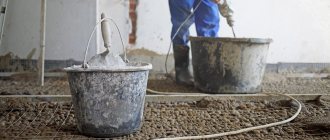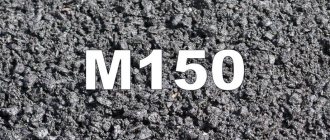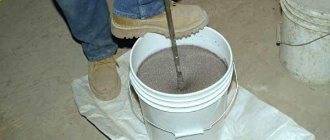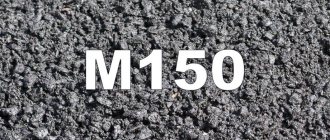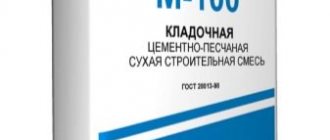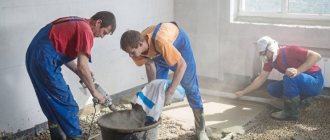The consumption of M150 mixture per 1 m2 of screed is the main parameter that determines the cost of pouring the floor, duration and resource costs. It is very important to be able to correctly calculate the consumption of a cement mixture, because an insufficient volume of solution will lead to technological downtime and deterioration in the quality of the pouring layer due to interruption; exceeding the required volume will lead to unjustified costs (after all, the prepared mixture must be used within 2 hours, then it will be unusable) .
Despite the huge variety of flooring materials on the market, the M150 mixture is considered the most optimal choice due to its reasonable cost, versatility, good technical characteristics, and ease of installation. It is also important that the mixture dries quickly enough and can be used not only for pouring screed, but also for plastering, laying walls made of brick and other blocks, as well as for other work.
Dry universal mixture M-150: pros and cons
Today, almost every construction market is ready to offer its consumers a variety of dry mixtures that can greatly speed up and facilitate the process of construction work.
Typically, these mixtures are made from cement and sand. And in order to improve the technological properties, plasticizers are added to them. Special ingredients make this mixture unique and inimitable.
After purchase, the consumer only needs to carefully study the instructions for use and preparation proportions, and then simply open the package and pour out the required amount of the mixture. Then you need to add a small amount of water and stir until a homogeneous mass is formed. M-150 is a mixture that has the same instructions for use and production.
This material is used for such types of work as installation, laying and finishing. M-150 is an excellent and budget option. Many consumers choose this one, since this option is considered one of the most indispensable in the construction process.
Application of sand concrete m150
The M150 marking classifies this sand concrete as heavy concrete. That is, you can safely use it to fill the foundation for massive structures, without worrying about the fact that in the future this structure will be subject to geometry violations.
As for the scope of use of such sand concrete, there will be no restrictions on its owner. Versatility in use is one of the most important factors that speaks in favor of purchasing this particular product.
If you want to find out more information about our products, discounts and promotions, you need to contact our managers by phone, which is listed on the main page of our website, or online. Our staff will provide you with a free consultation and provide comprehensive assistance during the ordering process. Contact us!
Peculiarities
It is worth noting the many features that this mixture includes. Created using special technologies, M-150 is known for its unique qualities, indispensable during construction or repair.
The amazing ratio of all components gives this mixture such qualities as:
- reliability;
- high quality;
- economical consumption;
- high resistance to moisture;
- good adhesion to various substrates;
- Possibility of use for both interior and exterior work;
- resistance to frost;
- ability to conserve heat;
- excellent sound insulation;
- vapor permeability.
Each package of this material weighs about 50 kg, which corresponds to 0.038 m3.
Separately, it is worth mentioning the possibility of creating an even layer during construction or repair. When finishing with this material, chips, bumps or cracks will never occur, unless the consumer made mistakes when preparing the solution and its application. This quality should be considered a huge plus, as well as extremely high strength. Thanks to this, both artificial and natural stone can be safely laid on top of the dried mortar. At the end of the work, the area covered with the dried solution will remain uniform, dense and level.
But this mixture can also be used in every region of the country, and in any weather conditions, since its frost resistance allows this to be done.
In addition to the above, you also need to know about the features of using and mixing the M-150 mixture. When mixing this material, you should strictly follow all the mixing rules.
This mixture must be applied and consumed within a maximum of 2 hours after mixing it , otherwise it will become extremely hard and it will simply be impossible to apply it. It is because of this that it is necessary to prepare and clean the area to be treated long before applying the material.
Substances such as oil, dust and grease can reduce adhesion, which makes the connection much less quality. The crumbling areas must be removed before starting construction or finishing work. The same should be done with formations such as moss, algae and fungus. It would be a good idea to treat the affected surfaces with some kind of fungicidal preparation.
Surfaces into which moisture penetrates are treated with a primer. You can also do multiple moisturizing. Each such moistening is carried out only after the early coating has completely dried.
Cement-sand mixture M150: technical characteristics, density, weight, consumption
Cement-sand mixtures are the most common material that people use during construction and repair work. They are produced on the basis of cement and sand. In order to improve technological properties, various additives (plasticizers) are introduced into the product during production. Cement mixtures are used at all stages of production, starting with the construction of the foundation and ending with plastering the walls. To obtain the finished composition, you just need to add water and stir for a few minutes. Due to their ease of preparation, such compositions are very popular. Let us consider in more detail the technical properties and characteristics of M 150, as well as methods of its application.
Types of mixtures
The variety of cement and sand-based mortars on the market is large, but the most popular are the brands from M100 to M300, which are most often chosen for certain work due to their versatility, low cost, and ease of use.
M100
A solution of cement-sand mixture M100 includes, in addition to the main components, lime in the composition. Therefore, the price of the dry mixture is slightly lower than analogues of a higher brand. A solution prepared on the basis of dry mixture M100 is suitable for eliminating minor defects in previously poured screeds, for leveling the base, plastering walls and ceilings.
M200
This composition is called masonry assembly. The material is presented on the market in several modifications, which are selected in accordance with the purpose of the mortar: for plastering, pouring screeds, masonry. Given a thickness of 5 millimeters, the consumption of the M200 dry mixture is about 8.5 kilograms per 1 m2.
M300
This cement-sand mixture is called foundation, since it is usually used when pouring prefabricated, strip or monolithic slab foundations. The cost of the material is quite high compared to other brands. The solution is also used in arranging screeds and laying block structures. About 19.5 kilograms of mixture are used per square meter.
M150
This composition is considered universal, since it is suitable for almost all types of work: laying walls from blocks, plastering various surfaces, pouring monolithic structures, manufacturing products, repairing and restoring collapsed concrete monoliths, etc. In addition, if necessary, the M150 mixture can replace any other.
The finished cement-sand mortar may already contain various additives or involve the introduction of plasticizers and additives into the mixture at the time of its preparation. The final composition of the components is selected based on the tasks and conditions of the work and the further operation of the concrete.
The main areas of application of the composition: internal/external finishing work, pouring foundations and floors, ceilings and plinths, finishing facades and laying walls, carrying out work in rooms with high levels of humidity and various aggressive influences.
To prepare the dry mixture, just add water according to the instructions and mix thoroughly. If necessary, you can make the solution yourself by taking the necessary materials in certain proportions.
Properties of cement-sand plaster
Dry CMC mixture M150 is used for plastering walls, ceilings and other surfaces and is a universal construction mixture. In addition, this material can be used provided that subsequent processing involves painting, filling and wallpapering.
Cement-sand mixture M150 can be used for laying walls, concreting stairs, repairing floors, sealing concrete walls and areas where there is fallen plaster. This composition can be applied to surfaces made of concrete, brick and cement. The thickness of the applied layer will be 5-50 mm.
The cement plaster and masonry mixture M150 is characterized by the following properties:
- Possibility of leveling walls and ceilings without using plaster stacks. In this case, the layer should have a thickness of 30 mm.
- High degree of adhesion to various substrates.
- Vapor permeability.
- Weather resistance.
- Frost resistance.
- Can be used for interior and exterior work.
The cement consumption per 1 cubic meter of solution is the amount specified in this article.
The video shows the technical characteristics of cement sand mortar (CSM) m 150:
Sales of dry mixes for general construction purposes
Sale of dry masonry mixtures and universal compositions of our own production is one of our specializations.
We sell building materials wholesale and retail, offering the most favorable terms of cooperation. From us you can buy at more than affordable prices dry masonry and installation mixtures suitable for application to surfaces made of brick, concrete and other materials. During the production process, we use proven technologies and carefully monitor product quality.
The mixtures we offer are certified. The characteristics meet the requirements of state standards. The established prices for dry masonry and installation mixtures with delivery are fully justified. We supply construction materials to organizations in the capital, Moscow region and other regions of Russia.
Technical characteristics of the DSP
Table 1 - Technical characteristics of the M150 cement mixture
As for consumption, on average 25 kg of the finished mixture per 1 m2 can be used when laying, and the thickness of the applied layer will be 10 mm. In addition, the consumption of the presented material is influenced by such factors as the thickness of the masonry material:
- ½ brick 25 kg/m2;
- 1 brick 50 kg/m2;
- 1 ½ bricks 75 kg/m2;
- 2 bricks 100 kg/m2e
The price of cement M 400 is indicated in this article.
How many materials will be needed?
The consumption of the mixture for the construction of 1 m3 of wall is influenced by the type of masonry and the size of the brick. The larger the dimensions of the blocks and the thinner the layer of mortar, the less of the latter is required.
The average consumption of the mixture used to construct 1 m3 of brick wall (for various types of masonry) is presented in the table below.
| Type of brick | Wall thickness in bricks | |||||
| 0.5 (120 mm) | 1 (250 mm) | 1.5 (380 mm) | 2 (510 mm) | 2.5 (640 mm) | ||
| Single (250 x 120 x 65 mm) | Brick, pcs. | 420 | 400 | 395 | 394 | 392 |
| Solution, m3 | 0,189 | 0,221 | 0,234 | 0,240 | 0,245 | |
| One and a half (250 x 120 x 88 mm) | Brick, pcs. | 322 | 308 | 296 | 294 | 292 |
| Solution, m3 | 0,16 | 0,2 | 0,216 | 0,222 | 0,227 | |
Ready-made masonry mortar
When you have purchased the presented mixture in bulk, it is poured into a container at the construction site, into which water is then sent. To obtain a homogeneous mass, it is necessary to thoroughly mix the resulting composition. When preparing the M150 mixture, the following proportions must be observed: water consumption 1.8 - 1.9 liters per 10 kg of dry mixture.
What are the grades of cement and their use are indicated in this article.
The prepared mixture must be applied using a trowel or spatula, but this must only be done after preparing the base in advance. After the mixture is ready for application, you should take care of moistening the surface.
In the video - cement-sand mixture (CSS) m 150:
You can learn about the characteristics of the M 500 cement brand from this article.
In addition, the surface must be dry, structurally sound and cleaned of various types of contaminants. Make sure that there are no old materials on the surface, otherwise it will be impossible to achieve good adhesion. If there are crumbling and weak areas, they need to be removed or repaired. For areas that are covered with moss, algae and fungus, it is worth cleaning with a steel brush.
After this, be sure to apply fungicidal compounds. If the surface is highly absorbent, then before applying the composition it is worth moistening or priming in several layers. In this case, be sure to wait until the first layer dries thoroughly.
Where and how to use cement grade 400 is indicated in this article.
Now you can proceed to preparing the mixture itself. Place the required amount of clean water in the container. Its temperature should be +15 – +20 degrees. When obtaining the solution, you should strictly follow the instructions. To obtain a solution of the required consistency, water consumption can be 190 ml per 1 kg. Gradually add the dry mass to the liquid and mix thoroughly using a mixer or drill with an attachment. It is necessary to mix the composition until a homogeneous mass is formed. Wait another 5 minutes, and then stir again, but there is no need to add water. The finished composition can be stirred when it is started.
After all the preparation work has been completed, you can begin finishing activities. First you need to fill large defects and cracks. The solution can be applied using a spatula or brush. Afterwards, smooth it thoroughly using the rule and grout. The grouting process can be carried out using a steel or plastic float.
You can find out what cement is made of from this article.
When the layer thickness exceeds 30 mm, then it is worth using a plaster mesh. If you are carrying out the process of leveling the wall, then you will have to apply the M150 mixture in more than one layer. But you need to distribute the next layer only if the previous one has already completely dried. After drying, the top layer must be leveled and rubbed. After sanding the base, you can then move on to wallpapering. But this can only be done after 24 hours, when the last layer has been applied.
During all work, it is important to observe temperature and humidity conditions. All work should take place in a dry climate, and the air temperature should be +5 – +30 degrees. And the humidity level should not exceed 80%, which directly affects the density of cement.
How to use cement GOST 10178 85 is indicated in the article.
The purchased mixture should be stored indoors and for no more than six months. Otherwise, the M150 mixture will lose its properties. The manufacturer guarantees that the mixture is dry if all the rules for storage, transportation and use were observed taking into account the requirements of GOST 28013-98.
Speaking about the cost of the presented product, it should be noted that it will depend on the volume sold. For a bag weighing 25 kg, you will have to pay 78 rubles.
What is the volumetric weight of cement is indicated in this article.
Dry mix M150 is a popular product that is widely used for plastering any surface. Unique properties and composition make it possible to achieve excellent adhesion to the surface, increasing its strength. After such treatment of the base, all subsequent finishing materials will remain on the surface for a long time.
Features of the universal dry mixture M150
Today, to speed up construction processes, a sufficient number of dry mixtures are produced. They are usually made on a cement base with the addition of sand and various plasticizers; all work with them comes down to adding water and stirring to the desired consistency. Next, we will consider the features of the universal dry mixture M150.
Self-preparation of the solution
The dry mixture M150 is sold in a ready-made version - you just need to mix it with water according to the instructions. But you can make the mixture yourself by mixing all the required components. The proportions of cement, sand, coarse filler can be different and depend on the purpose of the mixture, the brand of cement used, and the conditions of the work.
It must be remembered that long-term storage of cement or short-term storage in unsuitable conditions can cause poor quality of the solution. It is better to store cement for no more than 3 months on special wooden stands in closed factory containers, in conditions of low humidity and protection from precipitation. But it is best to buy cement immediately before starting work.
To fill the floor screed, take cement grades M400 and M500 in the following proportions: part cement, two parts sand (for M400) or three parts sand (for M500). To strengthen the floor and eliminate the possibility of deformation, you can add fiber fiber directly to the solution: 900 grams per cubic meter of solution.
The following recipe is suitable for masonry:
part cement and four to five parts sand (here the choice depends on the condition and quality of the sand - whether it is washed, dried, free of impurities, etc.). The solution is mixed in small portions so that it can be worked out within a maximum of two hours.
For plaster, a solution prepared from cement grades M200, M300 in the proportion of one part cement and three parts clean sifted sand is suitable.
It is advisable to mix all the ingredients using a special attachment on a drill. The proportions should not be changed - in attempts to save money, sometimes the proportion of cement is reduced, which leads to the spread of cracks, deformations, decreased strength, increased hardening time and other problems.
Peculiarities
Dry universal mixture M150 is intended for masonry, installation and finishing work. One of its main properties is the creation of an even plastic layer, which is necessary during construction, installation, bricklaying, and plastering. It is usually produced in bags of 50 kg, less often 40 or 25 kg. To prepare it, you just need to dilute it with the required amount of water indicated on the package and stir with a mixer.
Due to the presence of plasticizers and other components in their effective ratio, the dry universal mixture M150 has the following advantages:
- reliability and excellent quality;
- possibility of adhesion to many surfaces;
- frost resistance;
- economical consumption of material;
- good vapor permeability;
- protection from moisture.
The name “universal” speaks for itself. This means that this mixture can be used for many different jobs indoors and outdoors. It can be suitable for both moderate climates and severe northern frosts. Most often it is used for installation and laying of bricks and blocks, leveling surfaces, and concreting.
There are several varieties of the universal mixture M150, differing in composition and purpose.
- The plaster variety is intended for applying plaster manually or by machine; the layer thickness can be from 5 to 50 mm. It is suitable for facade and interior work. After mixing, the composition retains its beneficial properties for 120 minutes, so it is necessary to immediately begin applying plaster or not to mix large volumes. The applied composition acquires full strength after 28 days.
Specifications
Almost all manufacturers of dry mix M150 have the same composition, it includes:
- Portland cement brands PC400, PC500;
- dry sand with a fraction of 0.1-1 mm;
- mineral powder with a fraction of 0.1-0.5 mm;
- mineral additives and organic plasticizers.
All domestic manufacturers produce M150 mixtures in accordance with GOST 3051597, sand is used in accordance with TU 5711-002-05071329-2003.
The specific gravity or density of the cement-sand mixture M150 is 900 kg per m3, consumption is 16-17 kg per 1 m2 with a layer thickness of 1 cm, gray color, pot life no more than 2 hours, adhesion to the base 0.6 MPa, compressive strength 15.
Mortar M150 differs from M300 or M400 in that it can be used to produce not only masonry, but also screed and plaster. Only the proportions of dilution with water and methods of use will be different. The mixture must be diluted only with cold water.
The method of using the M150 product is as follows: the mixture is poured into a container with water in a ratio of 1.8-2 liters per 10 kg of dry composition and then mixed with a mixer or manually until a homogeneous mass is formed. After the solution is diluted, it must be used within 2 hours.
When laying bricks, the diluted mixture is applied in an even layer to the surface of the brick using a trowel and then leveled. The optimal thickness of the seams is from 1 to 5 mm, depending on the size of the blocks. When plastering, the solution is applied to the surface with a spatula, trowel or using a unit (plaster station), then it is drawn out with a rule to an even layer. Before plastering work, the wall must be covered with a deep penetration primer; if the layers are more than 3 cm, then beacons must be installed in advance.
Features of mixtures: characteristics, selection recommendations
Dry mix M150, like any other brand, consists of cement and sand.
Letter M
is the brand index, and the number next to it displays the load in kilograms per square centimeter that a completely frozen (within 28 days, as a rule) monolith can withstand. The indicator is approximate, since the strength of concrete is influenced by the quality of the raw materials, compliance with the technology for preparing the solution, correctness of pouring, conditions during the implementation of work and operation, etc.
But under ideal conditions, it is assumed that hardened concrete M150 can withstand a load of 150 kilograms per 1 square centimeter.
Main technical characteristics of cement-sand mixture M150:
- Appearance – dry gray powder of uniform composition.
- Temperature for use in work is from +5 to +30 degrees Celsius.
- Filler size – up to 0.8 millimeters.
- Water consumption per 1 kilogram of mixture is from 0.13 to 0.15 liters.
- Consumption per 1 m2, subject to an application thickness of 10 millimeters - 19 kilograms.
- The density of the hardened monolith is about 1500 kg/m3.
- The permissible thickness of the floor screed layer is up to 4 centimeters.
- Water holding capacity – 90%.
- Setting time – 2 hours.
- Hardening time – 24 hours.
- The full cycle of strength gain is 28 days.
When choosing a mixture of M150 for screed or plaster, masonry, you must carefully read the instructions and take into account the basic requirements for operation: expected loads, exposure to negative factors, the need for frost resistance and resistance to chemical factors, etc.
When calculating the mixture consumption, it is advisable to take into account that the specified standards on the packaging are aimed at experienced craftsmen and the most accurate adherence to technology. Actual consumption is usually 12% more.
The main competitive advantages of cement-sand mortar M150: economical consumption, versatility in use, high quality of all components (taken in the correct proportions), reliability and strength, good level of frost/water resistance, full compliance with GOST standards and requirements. The mixture is made on the basis of high-quality Portland cement of various brands, with the addition of clean sand, various impurities, and polymer additives.
A mortar based on dry mix M150 can be used for the following work: concrete floor screed, interior/exterior finishing, plastering, leveling ceilings, laying bricks, gas blocks and other types of building materials. Concrete is well suited as a base for subsequent wallpapering, painting, and puttying.
Cement-sand mortar is also used for cementing stairs, repairing and eliminating cracks in floors and walls, and restoring areas with damaged plaster. The solution can be used to level the ceiling without the use of reinforcing mesh, provided the layer is no more than 3 centimeters thick.
Manufacturers
Due to its popularity and versatility, the M150 building mixture is produced by a huge number of manufacturers. Almost every region has its own factories that produce this product and its own famous brands. Some cities even have dozens of manufacturers. Nevertheless, it is worth noting the most famous and popular domestic brands, known in Russia and the CIS countries.
- produces various types of dry mixtures for installation, repair and finishing work, among them M150 in 40 kg bags. Consumption per 1 cm layer is 15-17 kg per 1 m2. The solution can be used on concrete, brick, and stone surfaces at temperatures from +5 to +30 degrees. It is possible to purchase packaging of 25 kg, 50 kg. “Stone Flower” products made from high-quality Portland cement and dry sand receive positive reviews.
- Domestic produces M150 mixtures in 40 kg portions. They are perfect for sealing seams, concrete floor screeds, and plastering work. Modern technologies are used in production, the mixture undergoes quality control and certification. Consumption is relatively economical - for 10 kg of dry mixture you need to use 1.5-1.7 liters of water. After mixing, the initial setting occurs in 45 minutes, the solution completely hardens within a day.
- Sand cement M150 has reliably proven itself in the building materials market. There are 3 types of products: plastering, masonry and universal. All brands are available in 50 kg bags; for this volume you need to use 9 liters of water. Among the advantages of the universal construction mixture "Ivsil" we can note a wide range of operating temperatures from -50 to +60 degrees, increased viability - up to 3 hours, strength and frost resistance - up to 50 cycles.
- Dry mixes "Prestige-S" , made from Portland cement PC400, are used for many construction works. They are used for masonry, screed, concreting, grouting, ceramic and paving slabs. Composition strength – 150 kg per 1 cm2, frost resistance – 50 cycles, consumption per 1 sq. m with a centimeter layer - 17-19 kg of dry mixture. “Prestige-S” products are manufactured under quality control, and the building materials have a warranty.
- Domestic, in addition to many other high-quality building materials, offers dry mixes M150 based on high-quality Portland cement PC500 and mineral additives. The advantages of this company's products are durability and quality assurance. M150 “Osnovit” mixtures are supplied in 25, 40 and 50 kg packages in very colorful, bright packaging that can be immediately distinguished.
Optimal consumption M150
If we consider the M150 brand mixture, then the consumption per 1 square centimeter of floor screed is 22 kilograms, provided that the fill layer is 1 centimeter thick. The thickness of the layer can be any, but usually no more than 5-10 centimeters. The viability of a solution mixed with water is 2 hours, so the mixture is made in portions and poured manually. The monolith gains a full cycle of strength after 28 days.
The floor is strong and reliable, capable of withstanding considerable loads: bending strength is 2 MPa, adhesion – 0.5 MPa. To increase adhesion with further coating, the concrete floor is properly prepared (coated with various primers, impregnations, mechanically processed, etc.).
Adviсe
- It is very important to choose a trusted manufacturer of M150 sand cement. Despite the fact that the composition of all these products is almost identical, the physical properties may differ significantly, for example, in the grain size of cement or sand, frost resistance, the presence of impurities and other factors. Therefore, buying the M150 mixture cheaply does not mean it is profitable. You must carefully study the composition on the packaging, its warranty and shelf life, and purchase only from those manufacturers who have reliably proven themselves in the building materials market.
- After purchase, M150 mixtures must be stored unopened in a dry and dark room with a temperature of +10 to +35 degrees and a relative humidity of no more than 70%. Under such optimal conditions, the product retains its properties for 6 months; it is not recommended to store it without use for any longer.
- For the most effective use of the solution, the surface on which it is applied must be cleaned of large irregularities, fungus, mold, and moss. This will ensure better adhesion and less material consumption. It is also always recommended to prime the surface before use.
See the video below for the process of leveling walls with cement-sand mixture M150.
Application of masonry concrete
Sand concrete M150 is a universal building material that can be used at different stages of work. Typically, unloaded/medium-loaded structures are erected from mortar, and roughing/finishing work is carried out.
The mixture can be used to treat internal/external walls of different rooms. Work can be carried out even in frost thanks to the excellent frost resistance of sand concrete.
The main areas of application of sand concrete M 150:
- All types of masonry work - from paving slabs to brickwork
- Installation of road surfaces - here sand concrete guarantees reliable and strong adhesion of surfaces, which significantly extends the service life
- Primary plastering work to level walls and ceilings
- Creation of different types of partitions and walls
- Repair work - sand concrete is often used to seal and fasten cracks in railway structures, for example
- Pouring indoor screeds and concreting floors
- Implementation of the preparatory stages of work
- Preparing a foundation cushion, pouring light bases
- Various installation works (such as concreting pillars, for example)
- Leveling defects on concrete, brick, cement-limestone/sand surfaces
- Finishing of ceilings, walls for wallpapering, puttying, painting
Properties
Excellent properties of the mixture can be achieved through the correct selection of components and their proportions in the solution. Sand concrete demonstrates a compressive strength of 150 kg/cm2, which indicates strength category B12.5. Water resistance is at level W4, so the solution can be used to treat interior walls of both public and residential buildings.
The desired properties can be achieved by including Portland cement in the mixture as a binder. Cement prevents the mixture from delaminating and retains its positive characteristics under different conditions and under certain influences.
In many ways, the final set of properties depends on the correct choice of additives and determining their optimal volume from the total mass of the mixture (which is regulated by the requirements for the final solution and design calculations).
Compound
The quality and technical characteristics of M150 sand concrete are ensured by the correct composition. The established proportions are carefully observed and the best materials are selected.
Standard mixture composition:
- Thoroughly washed, clean, fine-grained river sand acts as the main filler.
- Portland cement M15 – binder component
- A variety of additives to adjust properties and improve performance
The binder is responsible for the adhesion of the solution to the base of the monolith on which the mixture is poured. The more Portland cement in the composition, the higher the frost resistance, density, water resistance, and strength.
Sand for preparing the mixture can be of fractions in the range of 0.8-2 millimeters. The quality of plasticizers affects the ease of laying, the elasticity of the solution, and additional properties. Depending on the volume of cement, filler, and water, sand concrete 150 can exhibit different characteristics.
Characteristics of masonry composition
Depending on the characteristics, the scope of application of M150 sand concrete is determined. Therefore, before using the mixture, it is necessary to carefully study all regulatory indicators and properties.
Main technical characteristics:
- Grade M150 is an indicator of compressive strength (equal to 150 kg/cm2, respectively)
- Strength class 12.5 – allows for the construction of moderately loaded/unloaded structures
- Frost resistance at level F50 - indicates the number of freezing/thawing cycles that the solution can withstand without obvious damage to the structure
- Mobility within P1-P4
- Water resistance W2-W4 – demonstrates the amount of moisture absorption
- Density in the range of 2100-2300 kg/m3 - this indicator is influenced by the quality and volume of the base material (solid aggregate, in the form of which sand appears here)
- Average hardening speed - sand concrete M 150 hardens quickly
Assembly and masonry mixtures for structures made of brick, concrete and other materials. Application
The dry masonry general building mixtures offered for sale are intended for finishing, cladding and leveling ceilings and walls. Used for external and internal work.
In addition, the materials are suitable for the construction of brick walls, installation of fireplaces and other structures, as well as:
- construction of staircase bases and floors;
- repair and treatment of concrete walls and construction joints;
- manufacturing of reinforced concrete products;
- laying paving slabs;
- sealing areas with crumbling plaster.
Choose a masonry mixture for bricks depending on your needs.
Preparing for work
Modern manufacturers offer ready-made dry mixture in containers of 50 kilograms or more, so there should not be any difficulties in preparing sand concrete 150. The package must contain instructions, according to which the mixture must be mixed with water and mixed with a drill with a special attachment until the mixture is homogeneous. Typically, up to 6 liters of water is sufficient for 50 kg of mixture.
Due to the ease of mixing and relatively low price, this sand concrete is very popular in individual construction. The solution has minimal subsidence, which allows you to accurately and correctly calculate the required volumes of building materials.
How to prepare a solution of sand concrete M150:
- Pour the required volume of dry mixture into any convenient container.
- Pour the mixture with cold, clean water (no impurities)
- Mix the mixture with a drill with an attachment or a low-speed mixer until the dough reaches a homogeneous state.
- Mix again after 10 minutes
- Use the M150 sand concrete solution for 2 hours (during this time the mixture can be stirred, but do not add water)
If you are preparing a lot of solution at once, it is advisable to use a concrete mixer, which will make it possible to quickly and efficiently mix all the components and make the optimal mixture. In Moscow and the regions, it is possible to order a ready-made mixture from the plant directly to the site.
Produced using technology and properly prepared on site, M150 sand concrete is a high-quality and reliable building material that is used in a variety of fields and makes it possible to implement many tasks.



